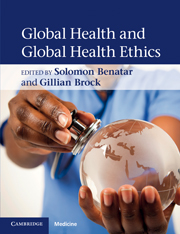Book contents
- Frontmatter
- Contents
- List of contributors
- Introduction
- Section 1 Global health, definitions and descriptions
- Section 2 Global health ethics, responsibilities and justice: some central issues
- Section 3 Analyzing some reasons for poor health
- 12 Trade and health: the ethics of global rights, regulation and redistribution
- 13 Debt, structural adjustment and health
- 14 The international arms trade and global health
- 15 Allocating resources in humanitarian medicine
- 16 International aid and global health
- 17 Climate change and health: risks and inequities
- 18 Animals, the environment and global health
- 19 The global crisis and global health
- Section 4 Shaping the future
- Index
- References
13 - Debt, structural adjustment and health
Published online by Cambridge University Press: 01 March 2011
- Frontmatter
- Contents
- List of contributors
- Introduction
- Section 1 Global health, definitions and descriptions
- Section 2 Global health ethics, responsibilities and justice: some central issues
- Section 3 Analyzing some reasons for poor health
- 12 Trade and health: the ethics of global rights, regulation and redistribution
- 13 Debt, structural adjustment and health
- 14 The international arms trade and global health
- 15 Allocating resources in humanitarian medicine
- 16 International aid and global health
- 17 Climate change and health: risks and inequities
- 18 Animals, the environment and global health
- 19 The global crisis and global health
- Section 4 Shaping the future
- Index
- References
Summary
Introduction
The debt narrative is encapsulated in the conundrum of why post-apartheid South Africa chose to cripple itself with debts that it could so easily have repudiated. Nelson Mandela described the apartheid debt as “the greatest single obstacle to progress in this country.” He explained further
We are limited in South Africa because our democratic government inherited a debt, which we were servicing at the rate of 30 billion rand a year. That is 30 billion we did not have to build houses, to make sure our children go to schools and to ensure that everybody has the dignity of having a job and a decent income.
(ACTSA, 2003; Malala, 2003)Given that debt accumulated by the apartheid system is an example par excellence of odious debt, the new democratic South Africa had compelling legal and ethical reasons for disowning it (Rudin, 1999, 2000).
Rather than disown the odious debt, the government actively sought to undermine Jubilee South Africa, the campaign founded to repudiate the apartheid debt (BusinessReport (SA), November 8 and 22, 1998).
Moreover, it is arguable that few governments or other creditors would have insisted on Mandela's South Africa repaying odious apartheid debts at the expense of the newly liberated black majority. Additionally, South Africa is far from being a poor country. Being the dominant economic power in Africa also gave the country political influence and both considerations put South Africa in a far stronger position to resist the debt burden than most other peripheral countries.
- Type
- Chapter
- Information
- Global Health and Global Health Ethics , pp. 155 - 165Publisher: Cambridge University PressPrint publication year: 2011
References
- 1
- Cited by

